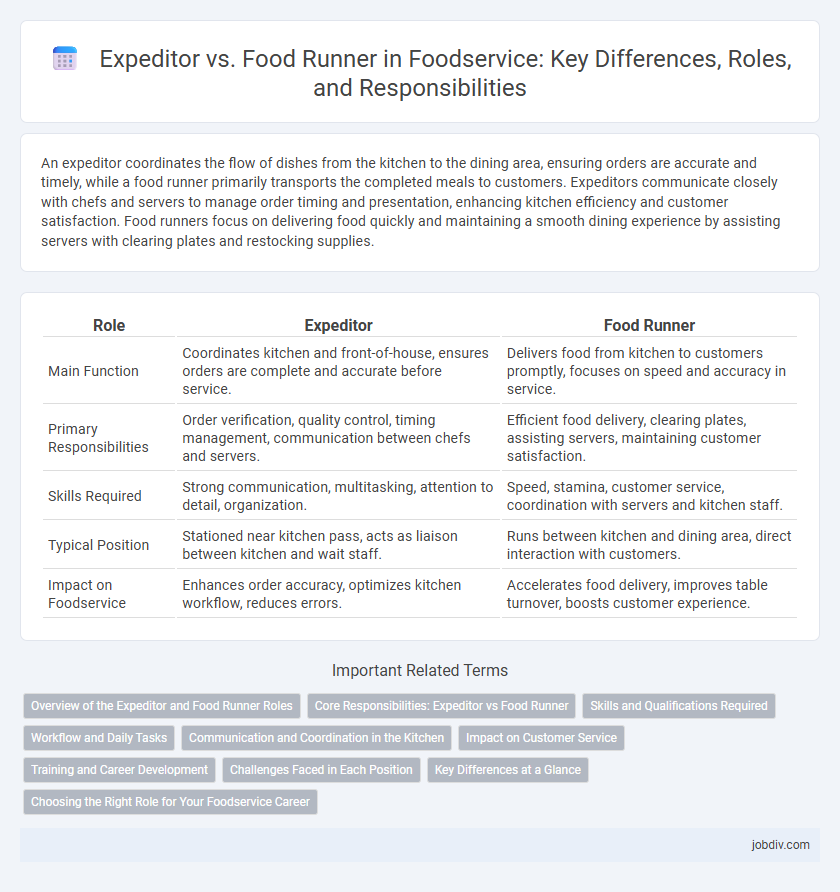An expeditor coordinates the flow of dishes from the kitchen to the dining area, ensuring orders are accurate and timely, while a food runner primarily transports the completed meals to customers. Expeditors communicate closely with chefs and servers to manage order timing and presentation, enhancing kitchen efficiency and customer satisfaction. Food runners focus on delivering food quickly and maintaining a smooth dining experience by assisting servers with clearing plates and restocking supplies.
Table of Comparison
| Role | Expeditor | Food Runner |
|---|---|---|
| Main Function | Coordinates kitchen and front-of-house, ensures orders are complete and accurate before service. | Delivers food from kitchen to customers promptly, focuses on speed and accuracy in service. |
| Primary Responsibilities | Order verification, quality control, timing management, communication between chefs and servers. | Efficient food delivery, clearing plates, assisting servers, maintaining customer satisfaction. |
| Skills Required | Strong communication, multitasking, attention to detail, organization. | Speed, stamina, customer service, coordination with servers and kitchen staff. |
| Typical Position | Stationed near kitchen pass, acts as liaison between kitchen and wait staff. | Runs between kitchen and dining area, direct interaction with customers. |
| Impact on Foodservice | Enhances order accuracy, optimizes kitchen workflow, reduces errors. | Accelerates food delivery, improves table turnover, boosts customer experience. |
Overview of the Expeditor and Food Runner Roles
The expeditor oversees the communication between the kitchen and front-of-house, ensuring that orders are prepared correctly and delivered promptly, maintaining food quality and presentation standards. The food runner is responsible for quickly transporting dishes from the kitchen to customers, assisting servers by facilitating efficient service flow. Both roles are essential in streamlining restaurant operations and enhancing the overall dining experience.
Core Responsibilities: Expeditor vs Food Runner
The expeditor coordinates the flow of orders between the kitchen and the dining area, ensuring accuracy, timing, and quality control before dishes reach customers. Food runners primarily focus on delivering food from the kitchen to guests promptly while maintaining proper presentation and temperature. Both roles are essential for efficient service, but expeditors manage order prioritization and communication, whereas food runners emphasize speed and customer interaction.
Skills and Qualifications Required
Expeditors require strong organizational skills, attention to detail, and the ability to communicate effectively between kitchen staff and servers to ensure timely food delivery. Food runners need physical stamina, multitasking abilities, and customer service skills to quickly deliver meals and accommodate special requests. Both roles demand teamwork and a thorough understanding of menu items, but expeditors often require greater leadership capabilities and problem-solving aptitude.
Workflow and Daily Tasks
Expeditors coordinate the flow of orders between the kitchen and front-of-house, ensuring timely plating and accuracy by inspecting dishes before service. Food runners deliver completed meals from the kitchen to guests promptly, maintaining proper presentation and temperature. While expeditors manage communication and order prioritization to streamline kitchen workflow, food runners focus on efficient meal delivery and customer satisfaction during service.
Communication and Coordination in the Kitchen
Effective communication and coordination in the kitchen are critical for both expeditors and food runners to ensure timely service. Expeditors act as the communication hub between the kitchen and front-of-house, verifying order accuracy and tracking preparation times, while food runners focus on delivering dishes promptly and confirming any last-minute requests with servers. This synchronized interaction reduces errors, maintains workflow efficiency, and enhances overall customer satisfaction in fast-paced foodservice environments.
Impact on Customer Service
Expeditors streamline communication between the kitchen and front-of-house, ensuring accurate and timely order delivery that significantly enhances customer satisfaction. Food runners support this process by quickly transporting dishes to tables, maintaining food quality and temperature for an optimal dining experience. Together, their coordinated efforts reduce wait times and improve overall service efficiency, directly impacting positive customer reviews and repeat business.
Training and Career Development
Expeditors in foodservice undergo extensive training in kitchen operations, order accuracy, and communication to coordinate between chefs and servers efficiently, fostering leadership skills for career advancement. Food runners receive practical training in speed, customer interaction, and menu knowledge, serving as an entry point for growth into roles like server or expeditor. Both positions offer foundational experience that supports upward mobility within the hospitality industry, emphasizing skill development and operational expertise.
Challenges Faced in Each Position
Expeditors often face challenges related to coordinating timely communication between the kitchen and front-of-house staff to ensure accurate and efficient order delivery, while managing order accuracy under high-pressure conditions. Food runners encounter difficulties in navigating crowded dining areas quickly and safely while maintaining food quality and temperature during transit. Both roles require exceptional multitasking skills and the ability to handle stressful environments to support seamless restaurant operations.
Key Differences at a Glance
An expeditor manages kitchen-to-service communication, ensuring orders are timely and accurate, while a food runner delivers dishes directly to customers. Expeditors coordinate between chefs and servers to maintain meal quality and presentation, whereas food runners focus on speed and customer interaction. The expeditor's role involves oversight and organization; the food runner's role emphasizes delivery and guest experience.
Choosing the Right Role for Your Foodservice Career
Selecting between an expeditor and a food runner role depends on your career goals within the foodservice industry. Expeditors coordinate orders, ensure timely plating, and communicate between kitchen and front-of-house staff, requiring strong organizational skills and attention to detail. Food runners focus on delivering dishes to customers promptly, emphasizing speed and customer interaction, ideal for those seeking a fast-paced, guest-facing position.
Expeditor vs Food Runner Infographic

 jobdiv.com
jobdiv.com